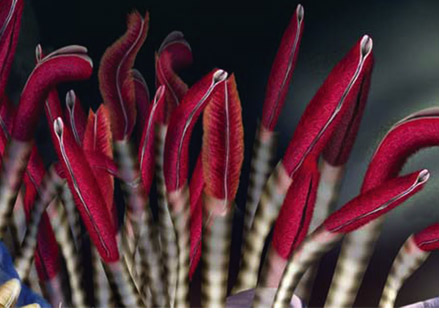For countless years, scientists believed the assumption that all the life on Earth was based on ecosystems with photosynthetic organisms (organisms getting energy from sunlight) as their foundation. Even the deep sea creatures that managed to survive in the pitch black zones of the ocean were thought to depend on sun-based food webs. And while it’s true that many deep sea organisms feed on small animals and falling debris from the ocean’s surface, in 1977 a group of scientists discovered an entirely new form of life.
The first hydrothermal vent (also known as a “black smoker”) was discovered in 1977 by the scientists of the Galapagos Reef Expedition. The scientists, who were mapping the bathymetry of the area’s seafloor, came upon the vent surrounded by giant tube worms about eight feet tall. It was an amazing discovery. Up until this point, sedentary organisms weren’t thought to be able to survive in the desolate ocean floor landscape. The seafloor was thought to be so bare, that the group didn’t even have a biologist with them on the expedition.
When Robert Ballard, the Co-Chief Scientist of the historical expedition spoke at a class of mine in college, he said that when they brought the worm back to the surface, they had to confiscate all the alcohol of everyone on the vessel in order to preserve the sample. (No biologist equals no formaldehyde.) The only way to maintain the worm was to submerse it in high-proof liquor and, unfortunately for the members of the cruise, eight feet of worm takes a whole lot of vodka to preserve it. The remaining scientists, though not very pleased to lose their entertainment on the long research cruise, seemed happy to aid in the discovery. John Edmond, the geochemist on the expedition is quoted as saying “We were dancing off the walls…it was a discovery cruise…like
So, how did these miraculous worms survive? How did they even evolve? Well below the 1000 meter depth mark that bids goodbye to the last particles of light from the surface; their ecosystem was thriving despite the seemingly impossible conditions. As it turns out, their proximity to the hydrothermal vents was no coincidence. Here, miles below the surface, a new base to the food web had developed.
The smoking vents are actually towers of crystalline zinc sulfide, blowing sulfur-rich smoke that can reach temperatures of over 700 degrees F. This ecosystem relies not on the photosynthesis of the rest of the world but instead on special chemosynthetic bacteria. These bacteria are the base of the food web for the rest of the vent area, directly and indirectly feeding a whole myriad of species never before seen. Bright red tube worms, blind shrimp, and giant crabs are just some of the more than 300 specially evolved species that exist in these unique vent ecosystems. Geochemist Gisela Winckler says that, “Most of the deep ocean is like a desert, but these vents are oases of life and weirdness.”
The harsh smoke in the waters can have a pH as low as 2.8 (an acidity higher than table vinegar) and biologists have reported seeing “naked snails” that were unable to form their calcium
carbonate shell because of the harsh pH environment.
Despite the environment, these areas are some of the most fertile all the ocean, rivaling coral reefs with their levels of unique biodiversity thanks to the bacteria that feed on the seemingly noxious soup of chemicals spewing from the vents. Deep sea shrimps have been known to number in the millions near these vents.
Since they were discovered, hydrothermal vents have been a focus of origin of life studies. Chemosynthetic ecosystems like these may very well be where the first life on Earth developed. If life can exist in such harsh conditions on earth, could it exist elsewhere in the universe?
This is exactly what many scientists believe.
Jupiter’s ice moon Europa, which is commonly believed by planetary scientists to house a subsurface ocean is a likely candidate for hydrothermal vent activity due to the fact that the planet’s bulk composition is similar to Earth’s. Elsewhere in the Solar System, the Mars rover “Spirit” has been dragging one wheel around the surface of Mars for quite a few years. One of the gouges from the wheel revealed a mineral deposit on the Mars surface. Scientists believe that this mineral deposit was most likely caused by hydrothermal vent activity, implying that a large amount of water was present on the planet’s surface when the vent was active.
While not necessarily little green men, it’s still entirely plausible that since life exists on the desolate seafloor, that life exists in other seemingly impossible environments in our galaxy in the deep, dark reaches of space.
You just shouldn't expect to get abducted by a tube worm.
Though it might not be exactly what he meant, like Fox Mulder, I want to believe.







No comments:
Post a Comment